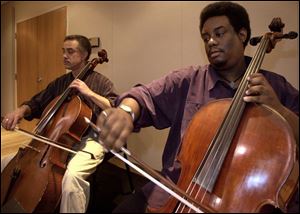
Cellist helps paint `Lincoln Portrait'
2/22/2002
After `Lincoln,' Robert Clemens, left, and Damon Coleman will play a Vivaldi concerto.
Opportunity strikes in unusual places. For 15-year Toledo Symphony veteran cellist Robert Clemens, the location was the stage door of the Toledo Museum of Art Peristyle. A few years ago, Clemens was joking with colleagues and trying out some of his celebrity imitations when John Hancock, the orchestra's former director of concert operations, walked by.
A few days later, Hancock asked Clemens if he wanted to try his hand at narration with the orchestra.
“I guess he thought I had another measure of talent that might be exploited by the symphony,” joked Clemens.
“I was flattered and also taken aback. Usually my job is to keep my mouth shut and let my cello do the talking.”
Since then, Clemens has narrated a variety of works, including “Peter and the Wolf” and Copland's “Lincoln Portrait.”
Clemens will perform the Copland work as part of a Toledo Symphony program, “Resurrection: Celebration of the American Spirit,” to be presented at 4:30 p.m. Sunday at St. Martin de Porres Church.
“The first time I did the piece, to prepare I went out and got the recording with Charlton Heston. When I listened to it though, all I could think was, `This is Moses here. I am way out of my element,'” Clemens said this week.
In Moses' case, perhaps Clemens was out of his element. But not in Lincoln's.
After all, Lincoln was no Moses.
But he was a visionary. A plain-speaking lawyer, Lincoln's everyday speech, if not his oratory, was heaped in the sounds of the vernacular. Lincoln identified with, and stood for, the common man. He was consistently out of sorts with the high culture of Washington, where many considered the 16th president a country bumpkin.
Copland understood Lincoln's vision. As grand as the words of the narrative are, they depend on a certain quiet humility in their recitation.
Indeed, directions in the original score called for an understated narrative style.
Copland wrote the piece so that the work itself would carry the emotional content, said Clemens.
“The nature of its power comes from the universality of its message. I found that a certain amount of detachment is required. It's a highly effective piece, as long as I don't try to do too much.
“The first time I had a public performance, it took a good amount of willpower to keep from choking up. There is a spot where the narration depicts Lincoln's persona. The music is so effectively written that it took all I had to be sure I could maintain my part of the program,” said Clemens.
After the Copland work, Clemens will join fellow cellist Damon Coleman, who is now in his second year in the orchestra, in a performance of Antonio Vivaldi's Concerto for Two Cellos.
Other program highlights include a medley of William Dawson spirituals performed by the David Carter Symphonic Chorale and Copland's “Fanfare for the Common Man.”
Robert Clemens and Damon Coleman will be featured with the Toledo Symphony at 4:30 p.m. Sunday at St. Martin de Porres Church, 1119 West Bancroft St. Tickets are $10, $5 for seniors and students. Information: 419-241-4544.